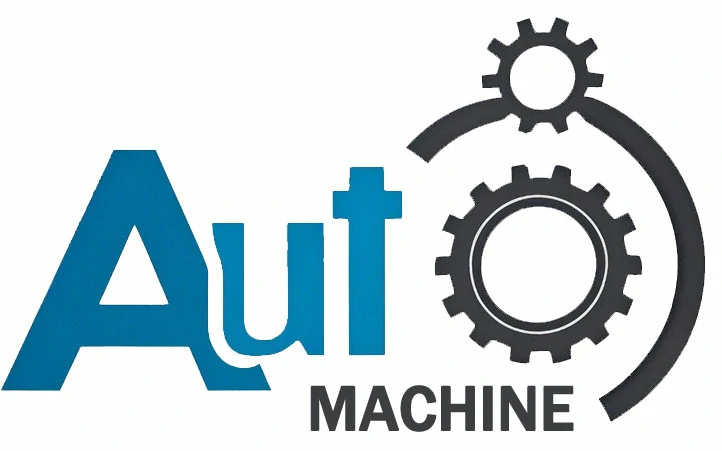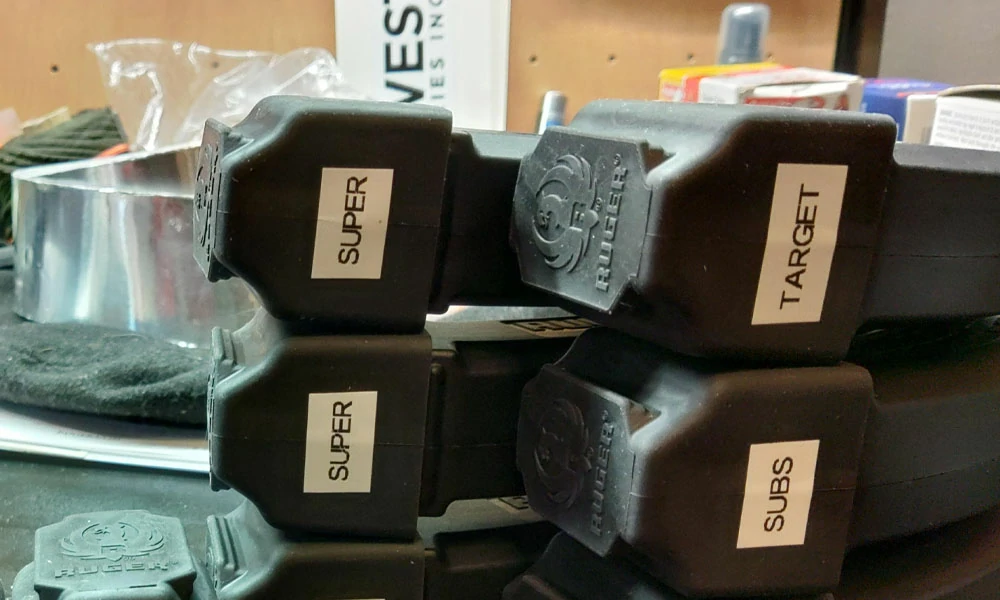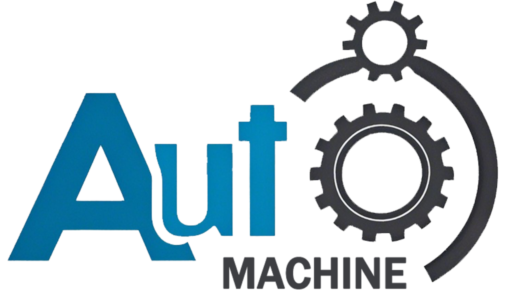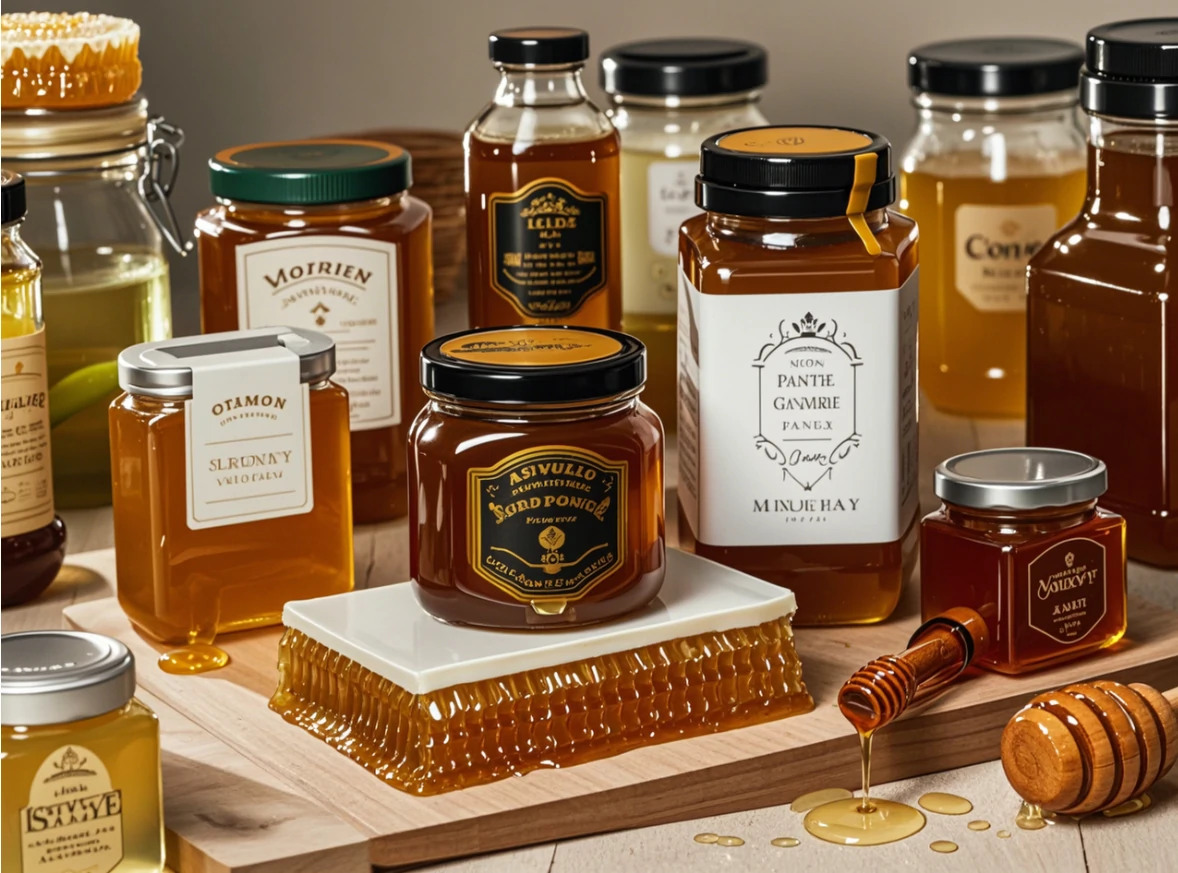
If you make money off of honey, you need to label your jars properly, and in the United States, honey jar labels must comply with FDA regulations, also known as the U.S. Food and Drug Administration’s (FDA) Honey Labeling Act. Properly labeling honey is critical for compliance and customer trust, and ensuring that your labels meet these requirements can protect your business from mislabeling or misrepresentation. This article will introduce you to what must be included on honey labels, compliance with the regulations, and a guide to honey labeling from production to placement.
Labeled honey must:
Include the word “honey” to identify the product
include the weight (not just the volume) of the honey in the jar or bottle
Include the name and address of the manufacturer (that’s you!)
You cannot:
If your product contains honey and other sweeteners (e.g., corn syrup), label and sell it as “honey”!
If your product contains any additives or flavorings, label it as “honey” and sell it.
Basic Honey Labeling Requirements
Labels must convey the following information:
Common Name
First, the “common” name of the product should be visible on the label – in this case, “honey” should be visible. If the honey is from a predominantly floral source, the name of the plant or flower (e.g. clover honey) should also be indicated.
Net weight
Next, the net weight of the honey should be stated on the label in pounds per ounce and grams. The weight should be printed in an easy-to-read format and should be placed on the lower third of the front label.
When calculating net weight, use the government conversion standards, 1 ounce (oz.) = 28.3495 grams or 1 pound (lb.) = 453.592 grams. Conversions should be rounded up, not down, and the net weight on the label should not exceed three decimal places.
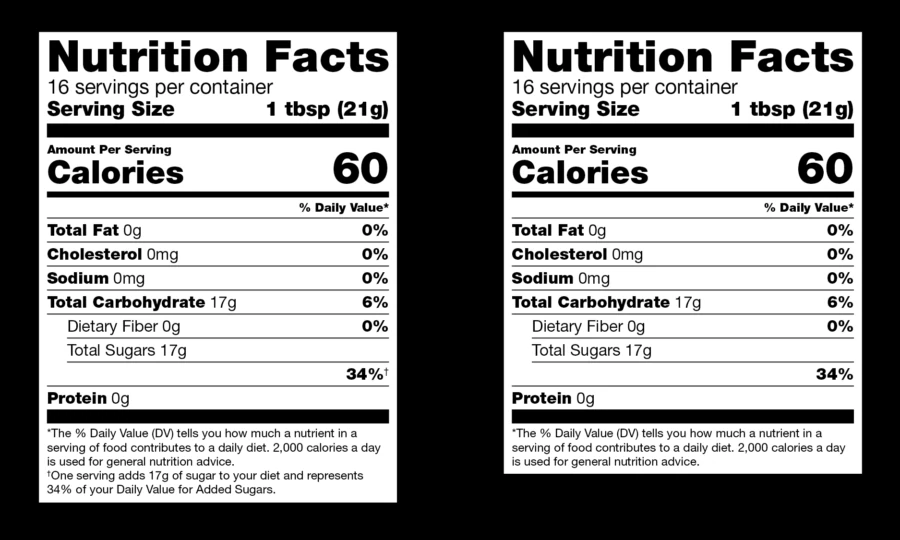
Ingredients
As honey is a single-ingredient product, it does not need to be labeled when the ingredient is already included in its common name. If the honey contains ingredients other than honey, an ingredient statement should be included – spices, flavorings, and incidental additives, except for “additives that have no functional purpose and are present in the finished product in very small amounts”.
The font size should follow the following guideline: “Ingredient listings should be in a font size no smaller than 1/16 inch in lowercase ‘o’ units, or in uppercase ‘O’ units if all capital letters are used in the statement. The font size for small packages is also limited. There are exceptions to the font size for small packages.”
Country of Origin
If your honey is imported, the country of origin must be stated in English, even if the label already contains an approved USDA mark or grade statement. The Federal Register contains additional labeling information for imported products.
Contact Information
Honey labels must contain the seller of the honey and their contact information, including the name and address of the manufacturer, packer, or distributor. This is referred to as the “signature line” and must be placed on the front label or information panel. If space is available, the full address and phone number should be included and all information should be at least 1/16 inch in height.
Color Markings for Honey
The U.S. Department of Agriculture (USDA) specifies the standard names of seven different colors that must be shown on honey labels. The seven color ranges include:
- Water-white: “Honey that is the color of water-white or lighter.”
- Extra White Honey: “Darker in color than water-white honey, but not darker than extra white honey.”
- White: “Darker in color than extra white honey, but not darker than white honey.”
- Extra Light Amber: “Darker in color than white honey, but not darker than extra light amber.”
Light Amber: “A honey that is darker in color than extra light amber, but not darker than light amber.” - Amber: “A honey that is darker in color than light amber, but not darker than amber.”
- Dark Amber: “Honey that is darker in color than amber.”
Honey Grade Requirements
Finally, the grade of honey, or the quality of the honey, needs to be indicated on the label. According to the USDA, there are four grades of honey:
- “U.S. Grade A means that the quality of the extracted honey meets the applicable requirements of Tables IV or V with a total score of at least 90.”
- “U.S. Grade B means that the quality of the extracted honey meets the applicable requirements of Tables IV or V with a total score of at least 80 points.”
- “U.S. Grade C means that the quality of the extracted honey meets the applicable requirements of Table IV or V with a total score of at least 70 points.”
“Fail means that the quality of the extracted honey does not meet the requirements for US Grade C.”
Once your honey meets all of these requirements, it complies with federal labeling regulations.
How to make honey labels
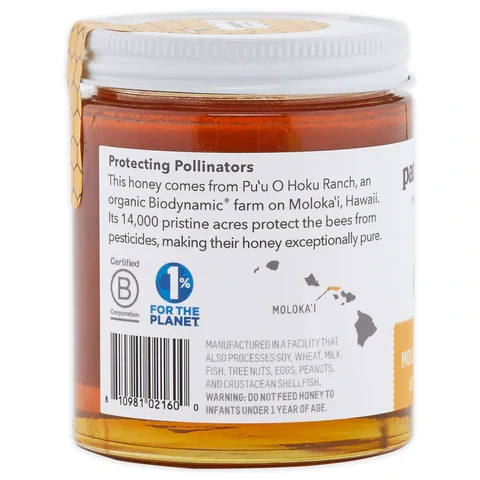
Design size and shape
After gathering all the information needed for honey labels, it is time to start designing the labels. It is important to consider the honey packaging container when designing the size and shape of the label.
There are many options for labels, from bottles and jars to squeezable containers. Honey containers are often interestingly shaped and require unconventional label shapes to match.
If your container is square or hexagonal and has multiple sides, consider label placement; curves and angles are more difficult to label than flat surfaces. You can also utilize the space at the top of the lid of the can with individual labels, label seals, or even one-piece labels that combine the lid, seal, and main section.
We have a large selection of molds in common sizes and shapes, or we can easily use custom designs. Different labeling machines are often best suited to specific sizes and formats, so be sure to check how you will be labeling.
Materials
Your labels have an important task – they need to stick well to the container and form the right appearance. Simple paper labels are not suitable for all applications. The information below will help you choose the right material and adhesive for your specific needs:
How are your honey labels applied – by hand or through an applicator (which type)?
Where do you apply your honey labels – in a cold environment or at room temperature?
What containers do you apply honey labels to – PET, glass, or plastic?
What conditions are the honey labels exposed to once applied to the jar?
The labeling material you choose will have a major impact on how consumers perceive your honey. Metallic materials have a reflective, shiny effect that attracts consumer attention.
Another popular material choice is clear film, as it gives the package an elegant “no label” look while allowing the consumer to see the honey. Other options include glossy paper or film, uncoated paper, paper with textured patterns, and even eco-friendly materials.
Creating label content
The content on the honey label is an important part of the package because it tells the story of the brand and the product. Most labels contain some or all of the following information:
- Brand
- Product name or description of the honey
- Variety, origin, plant, and other source information
- Weight
- Country of origin
- Ingredient list
- Nutritional information panel
- Instructions for use and storage
- Any warnings and advice statements
- Business information such as name and address
- Bar codes
- Date of packaging (usually printed on the label or container itself via ribbon, inkjet, or laser printer)
- The readability of content should be considered through size, color, and contrast.
Color choices for all elements of the label are critical to help solidify your brand positioning and create an eye-catching shelf presence.
Eye-catching decorations
Decor is a great way to convey a quality message and is one of the first places shoppers will notice your products.
- Hot and cold foils (even holographic patterns) in a variety of colors
- embossing
- Unique combinations of textured foils, foils, and embossing
- Screen printing and high-printing
- Laminates (gloss, matte and specialty)
- Gloss and matte varnishes (can be applied to the entire label or to certain areas to highlight design elements)
- Specialty tactile varnishes such as soft touch varnish and sandpaper varnish
- New types of varnishes such as glitter varnish, luxury gold varnish, scented varnish, etc.
There are countless creative ways to incorporate them into your honey label designs.
honey label placement
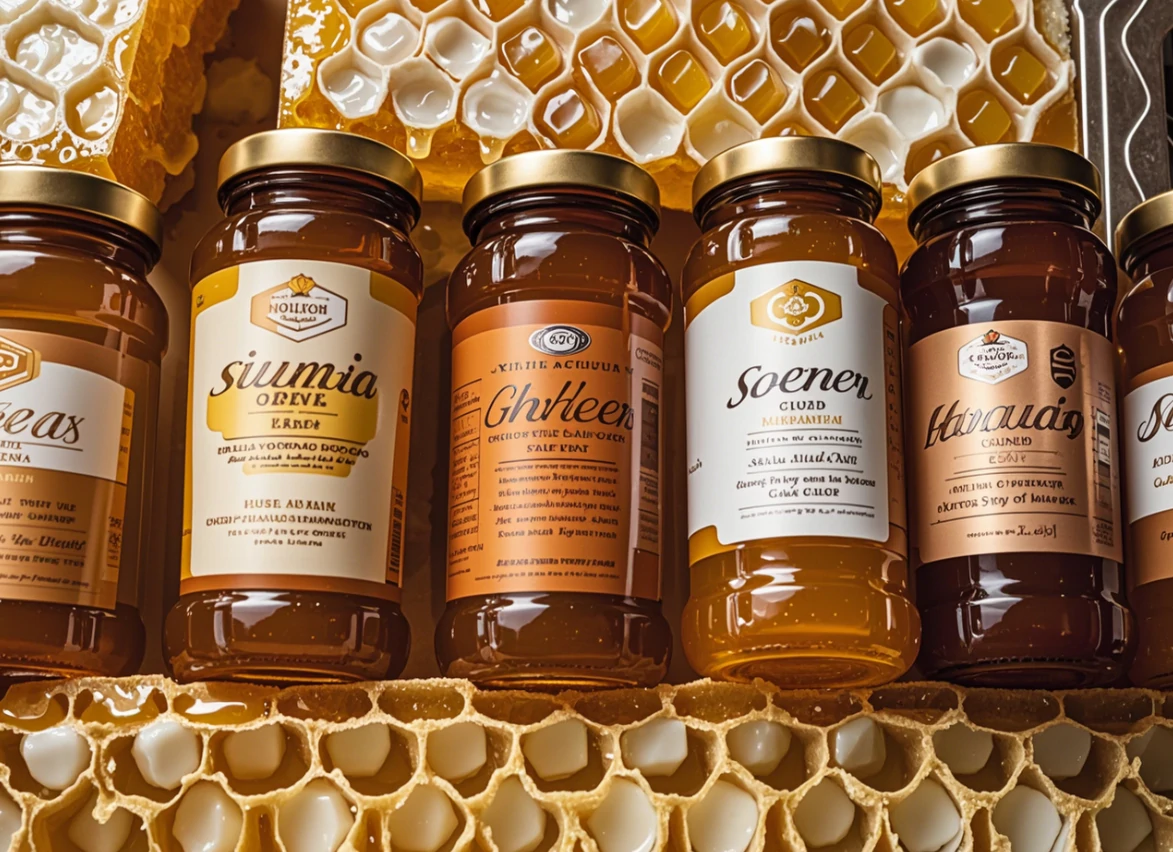
Honey labeling is a crucial final step in the production process, not only for the appearance of the product but also for the presentation of important product information. Once the honey labels have been beautifully designed, the next step is to consider how to apply them efficiently and accurately to the honey packaging.
Manual labeling: Manual labeling is a viable option when honey products are produced in small quantities. For example, small farms or artisanal workshops may only be producing small batches of honey for sale at local farmers’ markets or as specialty gifts. In this case, manual labeling allows for better cost control.
Benefits: AUTmachine Manual labeling is highly flexible. The operator can flexibly adjust the labeling position and strength according to the shape, size, and material of the package. For some specially designed honey labels, such as shaped labels or labels with special decorative requirements, manual labeling can better ensure the labeling effect.
Disadvantages: slow speed is the main disadvantage of manual labeling. Especially in the face of a large number of honey products needing to be labeled, manual labeling inefficiency will greatly affect the production schedule. Manual labeling makes it difficult to ensure that the position of each label is completely consistent, not enough precision, easy to appear skewed, and uneven situation. Automatic labeling machine: When honey products are produced in huge quantities, such as large honey processing plants, automatic labeling machines are essential equipment. These companies need to complete the labeling of large quantities of honey packages in a short period to meet market demand.
Working principle and characteristics: The automatic labeling machine has advanced sensors and control systems. It can automatically recognize the shape, size, and position of honey packages. During the labeling process, the package enters the labeling area through the conveyor belt, the sensor of the labeling machine will detect the arrival of the package, and then automatically remove the label from the label roll and accurately affix it to the preset position of the package, and the whole process does not require human intervention. Moreover, the automatic labeling machine can label multiple packages at the same time, which greatly improves production efficiency.
High efficiency: the labeling speed of the automatic labeling machine is very fast, and it can handle a large number of honey packages in a short time. For example, some high-end fully automatic labeling machines can label thousands of packages per hour, which is unmatched by manual and semi-automatic labeling machines.
Saving labor costs: Since the whole labeling process does not require human intervention, companies can greatly reduce the labor input in the labeling process, thus reducing production costs.
Which way do you plan to have honey labeling?
FAQ
To label honey, you’ll need:
Compliance with FDA regulations: Ensure the label meets all legal requirements set by the Food and Drug Administration (FDA) or local authorities.
Design Software: Tools for creating and printing labels, ensuring all information is clear, legible, and properly formatted.
Basic Information: Product name, ingredients list, net weight, manufacturer details, and certifications.
FDA Compliance Documents: Familiarity with FDA rules regarding the labeling of honey, particularly concerning claims like “raw” or “organic.”
To label your honey, you must follow the appropriate regulatory guidelines, ensuring that all essential information is included on the label. Key elements to include are:
Product Name: State “Honey” or specify the type (e.g., “Acacia Honey,” “Raw Honey”).
Ingredients: Honey should be the only ingredient unless flavorings or additives are added.
Net Weight: Indicate the weight or volume of the honey.
Producer Information: Include the name and contact details of the manufacturer or distributor.
Source: Specify if the honey is raw, filtered, or pasteurized, and its geographic origin (local or imported).
Certifications: If the honey is organic or has other certifications (e.g., non-GMO, fair trade), these should be prominently displayed.
Best Before Date: Include an expiry or best-before date if required by local regulations.
A honey label is a product label that provides essential information about the honey inside the container. It typically includes details like the honey’s origin, ingredients, processing method (raw, filtered, or pasteurized), and whether it’s organic. Understanding the honey label helps consumers make informed choices and ensure the honey meets their quality standards.
To properly read a honey label, look for key information such as the type of honey (e.g., wildflower, clover, or acacia), its source (local or imported), and whether it’s raw or pasteurized. Check for certification seals like USDA Organic or non-GMO. Also, look for additional notes on the packaging, like the honey’s color, floral origin, and the presence of any additives or preservatives.
Honey labeling is crucial because it helps consumers make informed decisions about the honey they buy. Clear and accurate labels, in line with the FDA guidelines, ensure that consumers can trust the purity, quality, and origin of the honey. It also helps differentiate raw, organic, and flavored varieties, making it easier to choose the best option for health and taste preferences.
